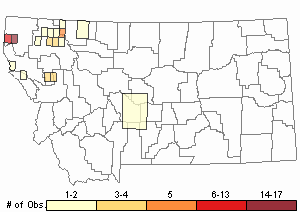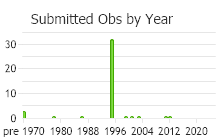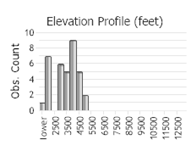View in other NatureServe Network Field Guides
NatureServe
Montana
Utah
Wyoming
Idaho
Wisconsin
British Columbia
South Carolina
Yukon
California
New York
Silver Moss - Niphotrichum canescens
Other Names:
A Torncap Moss,
Racomitrium canescens
General Description
Plants: Acrocarpous (Vitt 1988), growing prostrate to nearly upright (Flowers 1973), in open or crowded patches, greyish-green, chartreuse, or ochre, frequently frosty in appearance when dry. Stems 1-12 cm, but mostly 3-10 cm in height, erratically or pinnately branched with few to many branches, those bearing mostly smaller, tuft-like branches (FNA 2007).
Leaves: Straight or sickle-shaped, overlapping when dry (FNA 2007), patent to 90 degrees and recurved when wet (Flowers 1973), widely ovate-lanceolate, 1.5-3.3 mm in length, 0.8-1.3 mm in width (FNA 2007), unistratose (Flowers 1973), with a wide groove or faint ridge in the upper leaf; margins curved upwards and inwards, sometimes tightly so (FNA 2007), bistratose above (Flowers 1973); apex sometimes colorless, somewhat suddenly narrowed, often awned, the awns wide and firm or gradually tapering to a fine point, often with fine sharp teeth, very papillose above; costa about 1/2-3/4 leaf length and forked distally (FNA 2007).
Leaf Cells: Laminal cells wavy-walled (Vitt 1988); alar cells in 3-5 lines, swollen and fine-walled, clear to a slightly transparent pale yellow, forming auricles; the outer alar cells with long, thin straight walls, creating a translucent limbidium of about 25 cells; basal laminal cells oblong, each covered with several big papillae, frequently lacking papillae in the 1-3 rows nearest the attachment; medial and upper laminal cells papillate, oblong (FNA 2007), the upper ones short, sometimes quadrate, the medial cells usually longer (Lawton 1971).
Diagnostic Characteristics
This species is distinguished by its widely grooved to bluntly ridged leaf in the distal area, the thickset, finely toothed awns that are strongly papillate throughout, and the short, bifurcated costa ending about ½ to ¾ up the leaf (FNA 2007).
Range Comments
Greenland; Canada: NL; USA: CA to AK, MT, UT and MI (Flowers 1973). In Montana, known from Cascade, Flathead, Glacier, Lake, Mineral, and Missoula Counties (Elliott 2016).
Observations in Montana Natural Heritage Program Database
Number of Observations: 60
(Click on the following maps and charts to see full sized version)
Map Help and Descriptions
Relative Density

Recency



 (Observations spanning multiple months or years are excluded from time charts)
(Observations spanning multiple months or years are excluded from time charts)
Habitat
Rock and soil (Elliott 2016). Elevation: In northerly latitudes, from sea level, reaching the subalpine zones in the mountains and southward (Flowers 1973).
Reproductive Characteristics
Dioicous, with female and male plants much alike (Lawton 1971). Interior perichaetial bracts tissue-like, lacking pigment, typically with colorless awns. Seta 5-25 mm in in length, deep red or brown with reddish tones (FNA 2007), sinistrorse above (Lawton 1971). Capsule cylindric or a little broader in the middle, 1.5-2.5 mm in length, slightly grooved to smooth when dry (FNA 2007); operculum up to 2 mm, frequently as long as the theca (Lawton 1971); peristome teeth thickly papillate, brown with red tones (FNA 2007).
Stewardship Responsibility
References
- Literature Cited AboveLegend:
 View Online Publication
View Online Publication Elliott, J.C. and A.K. Pipp. 2018. A Checklist of Montana Mosses (1880-2018). Updated 3 January, 2020. Montana Natural Heritage Program, Helena, Montana. 73 pp.
Elliott, J.C. and A.K. Pipp. 2018. A Checklist of Montana Mosses (1880-2018). Updated 3 January, 2020. Montana Natural Heritage Program, Helena, Montana. 73 pp. Flora of North America Editorial Committee, eds. 2007. Flora of North America North of Mexico. Volume 27. Bryophytes: Mosses, Part 1. Oxford University Press, Inc., NY. xxi + 713 pp.
Flora of North America Editorial Committee, eds. 2007. Flora of North America North of Mexico. Volume 27. Bryophytes: Mosses, Part 1. Oxford University Press, Inc., NY. xxi + 713 pp. Flowers, S. 1973. Mosses: Utah and the West. Brigham Young University, Provo, Utah. 567 p.
Flowers, S. 1973. Mosses: Utah and the West. Brigham Young University, Provo, Utah. 567 p. Lawton, E. 1971. Moss Flora of the Pacific Northwest. Hattori Botanical Laboratory. Japan: Yamabuki-cho, Shinjuku-ku, Tokyo. 362 pages plus appendices.
Lawton, E. 1971. Moss Flora of the Pacific Northwest. Hattori Botanical Laboratory. Japan: Yamabuki-cho, Shinjuku-ku, Tokyo. 362 pages plus appendices. Vitt, D. J. Marsh, and R. Bovey. 1988. Mosses, Lichens & Ferns of Northwest North America. Seattle, WA: University of Washington Press. 296 p.
Vitt, D. J. Marsh, and R. Bovey. 1988. Mosses, Lichens & Ferns of Northwest North America. Seattle, WA: University of Washington Press. 296 p.
- Additional ReferencesLegend:
 View Online Publication
View Online Publication
Do you know of a citation we're missing? Elliot, J. C. 1993. Second checklist of Montana mosses. Unpublished report. U.S. Forest Service, Region 1. Missoula, MT. 45 pp.
Elliot, J. C. 1993. Second checklist of Montana mosses. Unpublished report. U.S. Forest Service, Region 1. Missoula, MT. 45 pp. Lawton, E. 1971. Keys for the Identification of the Mosses on the Pacific Northwest. Reprinted from 'Moss Flora of the Pacific Northwest'. Published as Supplement No. 2 of the Journal of the Hattori Botanical Laboratory. Nichinan, Miyazaki, Japan. 66 pp.
Lawton, E. 1971. Keys for the Identification of the Mosses on the Pacific Northwest. Reprinted from 'Moss Flora of the Pacific Northwest'. Published as Supplement No. 2 of the Journal of the Hattori Botanical Laboratory. Nichinan, Miyazaki, Japan. 66 pp.
- Web Search Engines for Articles on "Silver Moss"





